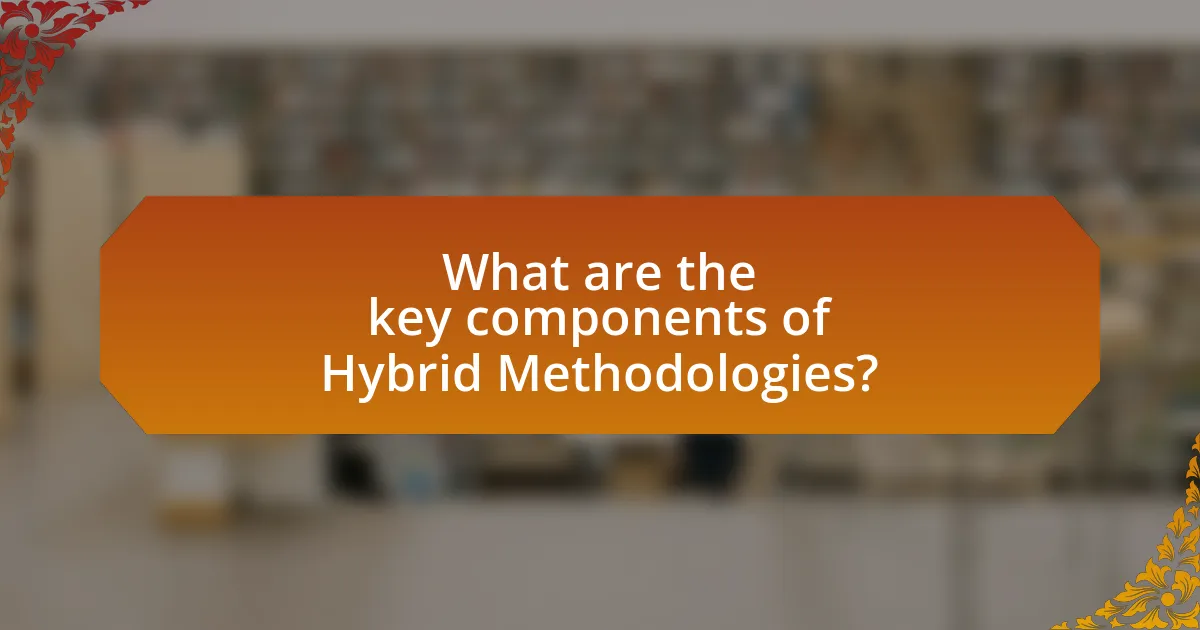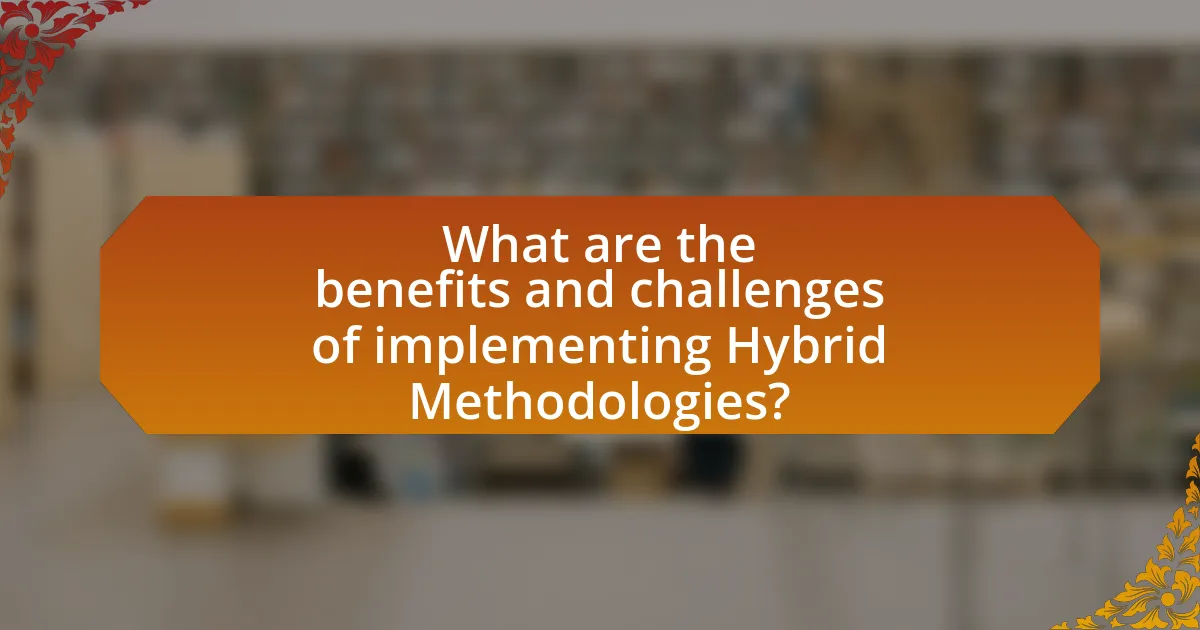Hybrid methodologies in project management combine elements of Agile and Waterfall techniques to enhance project outcomes by balancing flexibility and structure. This approach allows teams to adapt to changing requirements while maintaining a clear framework for planning and execution. Key principles of Agile, such as customer collaboration and iterative development, are integrated with Waterfall’s structured phases and documentation, resulting in improved stakeholder engagement and project success rates. The article explores the integration of these methodologies, the benefits and challenges of implementation, and best practices for effectively managing projects using a hybrid approach. Additionally, it discusses the tools and techniques that support this methodology, emphasizing the importance of training and stakeholder involvement in achieving successful outcomes.

What are Hybrid Methodologies in Project Management?
Hybrid methodologies in project management are approaches that integrate elements of both Agile and Waterfall methodologies to leverage the strengths of each. This combination allows teams to adapt to changing project requirements while maintaining a structured framework for planning and execution. For instance, a project may begin with a Waterfall approach for initial planning and requirements gathering, followed by Agile sprints for development and testing, enabling flexibility and responsiveness to stakeholder feedback. This method has been shown to improve project outcomes by balancing predictability with adaptability, as evidenced by studies indicating that hybrid approaches can lead to higher customer satisfaction and project success rates.
How do Hybrid Methodologies integrate Agile and Waterfall techniques?
Hybrid methodologies integrate Agile and Waterfall techniques by combining the structured planning and documentation of Waterfall with the flexibility and iterative nature of Agile. This integration allows teams to benefit from the predictability of Waterfall for project phases that require detailed upfront planning, while also leveraging Agile’s adaptability to respond to changes and stakeholder feedback throughout the project lifecycle. For instance, a hybrid approach may involve using Waterfall for initial project phases such as requirements gathering and design, followed by Agile sprints for development and testing, enabling continuous improvement and faster delivery of project components. This method has been shown to enhance project outcomes by balancing risk management with responsiveness to change, as evidenced by studies indicating that organizations employing hybrid methodologies report higher project success rates compared to those using a single approach.
What are the key principles of Agile that influence Hybrid Methodologies?
The key principles of Agile that influence Hybrid Methodologies include customer collaboration, iterative development, and adaptability to change. Customer collaboration emphasizes the importance of engaging stakeholders throughout the project, ensuring that their feedback shapes the product. Iterative development allows for incremental progress, enabling teams to refine and improve the product through successive iterations. Adaptability to change highlights the Agile principle of welcoming changing requirements, even late in development, which is crucial for Hybrid Methodologies that blend Agile flexibility with Waterfall structure. These principles collectively enhance project responsiveness and stakeholder satisfaction, making them essential for effective Hybrid Methodologies.
What are the fundamental aspects of Waterfall that are retained in Hybrid Methodologies?
The fundamental aspects of Waterfall retained in Hybrid Methodologies include structured phases, clear documentation, and defined project milestones. Hybrid Methodologies integrate these Waterfall elements to provide a systematic approach while allowing for flexibility in Agile practices. The structured phases ensure that each stage of development is completed before moving to the next, which helps in maintaining order and clarity. Clear documentation is emphasized to facilitate communication and understanding among stakeholders, ensuring that requirements and progress are well-documented. Defined project milestones from Waterfall provide measurable checkpoints that help in tracking progress and ensuring that the project stays on schedule. These aspects contribute to a balanced approach that leverages the strengths of both methodologies.
Why are Hybrid Methodologies gaining popularity in various industries?
Hybrid methodologies are gaining popularity in various industries due to their ability to combine the flexibility of Agile with the structured approach of Waterfall. This combination allows organizations to adapt to changing requirements while maintaining a clear project timeline and deliverables. For instance, a study by the Project Management Institute found that 71% of organizations using hybrid methodologies reported improved project success rates, highlighting their effectiveness in balancing responsiveness and predictability.
What challenges do traditional methodologies face that Hybrid Methodologies address?
Traditional methodologies, such as Waterfall, face challenges including inflexibility, slow response to change, and difficulty in accommodating evolving project requirements. Hybrid methodologies address these issues by integrating Agile principles, allowing for iterative development and adaptability throughout the project lifecycle. This combination enables teams to respond quickly to stakeholder feedback and changing market conditions, ultimately improving project outcomes. For instance, a study by the Project Management Institute highlights that organizations using hybrid approaches report a 20% increase in project success rates compared to those relying solely on traditional methods.
How do Hybrid Methodologies enhance flexibility and adaptability in projects?
Hybrid methodologies enhance flexibility and adaptability in projects by integrating Agile and Waterfall techniques, allowing teams to respond effectively to changing requirements. This combination enables project managers to utilize the structured planning of Waterfall while benefiting from the iterative and incremental nature of Agile, facilitating adjustments throughout the project lifecycle. For instance, a study by the Project Management Institute found that organizations employing hybrid approaches reported a 71% success rate in meeting project goals, compared to 64% for those using traditional methods alone. This evidence underscores how hybrid methodologies empower teams to pivot quickly in response to stakeholder feedback and evolving project dynamics.

What are the key components of Hybrid Methodologies?
The key components of Hybrid Methodologies include flexibility, iterative development, stakeholder collaboration, and structured planning. Flexibility allows teams to adapt to changing requirements, while iterative development promotes continuous improvement through regular feedback cycles. Stakeholder collaboration ensures that all parties are engaged throughout the project, enhancing communication and alignment. Structured planning integrates the predictability of Waterfall with the adaptability of Agile, enabling teams to manage risks effectively and deliver quality results. These components collectively facilitate a balanced approach that leverages the strengths of both Agile and Waterfall methodologies.
How do project phases differ in Hybrid Methodologies compared to traditional methods?
Project phases in Hybrid Methodologies differ from traditional methods primarily in their flexibility and iterative nature. In traditional methodologies, such as Waterfall, project phases are sequential and rigid, with each phase needing to be completed before the next begins, which can lead to inflexibility in responding to changes. In contrast, Hybrid Methodologies integrate Agile principles, allowing for overlapping phases and iterative cycles that enable continuous feedback and adaptation throughout the project lifecycle. This approach facilitates quicker adjustments to project requirements and enhances stakeholder engagement, as seen in studies highlighting improved project outcomes in environments that embrace flexibility and iterative processes.
What role does planning play in Hybrid Methodologies?
Planning is essential in Hybrid Methodologies as it integrates the structured approach of Waterfall with the flexibility of Agile. This duality allows teams to define project scope, timelines, and deliverables while remaining adaptable to changes. Effective planning ensures that initial requirements are documented and that iterative feedback loops are established, facilitating continuous improvement. Research indicates that projects utilizing hybrid methodologies can achieve a 20% increase in efficiency due to better resource allocation and risk management, demonstrating the critical role of planning in optimizing outcomes.
How is stakeholder engagement managed in Hybrid Methodologies?
Stakeholder engagement in Hybrid Methodologies is managed through a structured approach that combines elements of both Agile and Waterfall techniques. This management involves regular communication, iterative feedback loops, and clearly defined roles and responsibilities. For instance, Agile practices emphasize continuous stakeholder involvement through frequent meetings and updates, ensuring that stakeholders can provide input at various stages of the project. Conversely, Waterfall techniques establish formal checkpoints and documentation, which help in aligning stakeholder expectations with project deliverables. This dual approach allows for flexibility and adaptability while maintaining a clear framework for accountability, ultimately leading to improved stakeholder satisfaction and project outcomes.
What tools and techniques are commonly used in Hybrid Methodologies?
Hybrid methodologies commonly utilize tools and techniques such as Scrum, Kanban, Gantt charts, and project management software like Jira and Trello. Scrum facilitates iterative development and team collaboration, while Kanban visualizes workflow and limits work in progress. Gantt charts provide a timeline view of project tasks, integrating the structured planning of Waterfall with Agile’s flexibility. Project management software like Jira and Trello supports task tracking and team communication, enabling the blending of Agile and Waterfall practices effectively. These tools enhance project adaptability and efficiency, aligning with the principles of both methodologies.
Which project management software supports Hybrid Methodologies effectively?
Project management software that supports Hybrid Methodologies effectively includes Microsoft Project, Jira, and Trello. Microsoft Project allows users to integrate both Agile and Waterfall approaches, providing tools for Gantt charts alongside Agile boards. Jira is designed for Agile project management but also offers features that accommodate Waterfall elements, making it versatile for hybrid projects. Trello, with its customizable boards and lists, can be adapted to fit both methodologies, allowing teams to manage tasks in a way that suits their specific needs. These tools have been widely adopted in various industries, demonstrating their effectiveness in combining Agile and Waterfall techniques for optimal project outcomes.
How do Agile practices like Scrum fit into Hybrid Methodologies?
Agile practices like Scrum integrate into Hybrid Methodologies by providing iterative and incremental frameworks that enhance flexibility and responsiveness within traditionally structured environments. Scrum’s emphasis on short sprints and regular feedback loops allows teams to adapt to changing requirements while still adhering to the overall project timeline and milestones typical of Waterfall approaches. This combination enables organizations to leverage the predictability of Waterfall for planning and documentation, while simultaneously benefiting from the adaptability and continuous improvement principles of Agile. The effectiveness of this integration is supported by case studies showing increased project success rates when teams employ hybrid models, as they can better manage uncertainty and stakeholder expectations.

What are the benefits and challenges of implementing Hybrid Methodologies?
Implementing Hybrid Methodologies offers the benefit of flexibility, allowing teams to adapt to changing project requirements while maintaining structure through traditional Waterfall techniques. This adaptability can lead to improved project outcomes, as evidenced by a study from the Project Management Institute, which found that organizations using hybrid approaches reported a 20% increase in project success rates compared to those using solely Agile or Waterfall methods.
However, challenges include potential confusion among team members regarding roles and processes, as the integration of Agile and Waterfall can create ambiguity. Additionally, managing stakeholder expectations can be difficult, as different stakeholders may prefer one methodology over the other, leading to conflicts. Research from the International Journal of Project Management highlights that 60% of project managers face difficulties in aligning team members when implementing hybrid methodologies, indicating a significant challenge in achieving cohesive collaboration.
What advantages do organizations gain by adopting Hybrid Methodologies?
Organizations gain increased flexibility and improved project outcomes by adopting Hybrid Methodologies. This approach allows teams to leverage the structured planning of Waterfall while benefiting from the iterative and adaptive nature of Agile. For instance, a study by the Project Management Institute found that organizations using hybrid methodologies reported a 71% success rate in projects, compared to 64% for those using traditional methods alone. This combination enables better risk management, enhanced stakeholder engagement, and the ability to respond swiftly to changes, ultimately leading to higher customer satisfaction and project efficiency.
How do Hybrid Methodologies improve team collaboration and communication?
Hybrid methodologies improve team collaboration and communication by integrating the flexibility of Agile with the structured approach of Waterfall. This combination allows teams to adapt to changing requirements while maintaining clear project timelines and deliverables. For instance, Agile practices encourage regular feedback and iterative progress, fostering open communication among team members. Meanwhile, Waterfall’s defined phases provide a framework that helps teams stay organized and aligned on project goals. Research indicates that organizations using hybrid methodologies report a 30% increase in team satisfaction and a 25% improvement in project delivery times, demonstrating the effectiveness of this approach in enhancing collaboration and communication.
What impact do Hybrid Methodologies have on project delivery timelines?
Hybrid methodologies positively impact project delivery timelines by combining the flexibility of Agile with the structured approach of Waterfall. This integration allows teams to adapt to changes quickly while maintaining a clear project roadmap, leading to more efficient use of time and resources. Research indicates that organizations employing hybrid methodologies can reduce project delivery times by up to 30% compared to traditional methods, as they facilitate iterative progress and continuous feedback. This adaptability and efficiency are crucial in meeting deadlines and responding to stakeholder needs effectively.
What challenges might organizations face when transitioning to Hybrid Methodologies?
Organizations transitioning to Hybrid Methodologies may face challenges such as resistance to change, misalignment of team roles, and difficulties in integrating Agile and Waterfall practices. Resistance to change often stems from employees’ comfort with existing processes, leading to pushback against new methodologies. Misalignment of team roles can occur when team members are unclear about their responsibilities in a hybrid framework, resulting in confusion and inefficiency. Additionally, integrating Agile and Waterfall practices can be complex, as these methodologies have fundamentally different approaches to project management, which may lead to conflicts in workflow and communication. These challenges can hinder the successful implementation of Hybrid Methodologies, impacting overall project outcomes.
How can resistance to change be managed during the transition?
Resistance to change can be managed during the transition by actively involving stakeholders in the change process. Engaging team members through regular communication, feedback sessions, and training can help alleviate fears and build trust. Research indicates that organizations that prioritize stakeholder involvement experience a 70% success rate in change initiatives, as highlighted in the Prosci Change Management Best Practices report. By fostering an inclusive environment, organizations can reduce resistance and enhance the overall effectiveness of the transition.
What training or resources are necessary for successful implementation?
Successful implementation of hybrid methodologies, which combine Agile and Waterfall techniques, requires specialized training in both methodologies and access to collaborative tools. Training programs should focus on Agile principles, Waterfall project management, and the integration of both approaches, ensuring team members understand when to apply each methodology effectively. Resources such as project management software (e.g., Jira, Trello) and collaboration platforms (e.g., Slack, Microsoft Teams) are essential for facilitating communication and tracking progress across teams. Research indicates that organizations employing hybrid methodologies report a 20% increase in project success rates when teams are adequately trained and equipped with the right tools.
What best practices should be followed when using Hybrid Methodologies?
When using Hybrid Methodologies, it is essential to establish clear communication channels among all team members. Effective communication ensures that everyone understands their roles and responsibilities, which is crucial for integrating Agile and Waterfall techniques. Additionally, it is important to define project phases and deliverables upfront, allowing for structured planning while maintaining flexibility for iterative changes. Regularly reviewing progress through iterative cycles helps in adapting to changes and addressing issues promptly. Furthermore, leveraging tools that support both Agile and Waterfall practices can enhance collaboration and tracking. These practices are validated by numerous case studies showing improved project outcomes when teams effectively blend methodologies.
How can teams effectively balance Agile and Waterfall elements in their projects?
Teams can effectively balance Agile and Waterfall elements in their projects by adopting a hybrid approach that leverages the strengths of both methodologies. This involves defining project phases where Waterfall can be used for clear, structured requirements and planning, while Agile can be applied for iterative development and flexibility in response to change. For instance, a project can start with a Waterfall phase to establish a solid foundation and then transition to Agile sprints for development, allowing for ongoing feedback and adjustments. Research indicates that organizations using hybrid methodologies report a 30% increase in project success rates, as they can adapt to changing requirements while maintaining a clear project roadmap.
What metrics should be used to evaluate the success of Hybrid Methodologies?
To evaluate the success of Hybrid Methodologies, key metrics include project delivery time, cost variance, stakeholder satisfaction, and team productivity. Project delivery time measures how effectively the hybrid approach meets deadlines, while cost variance assesses budget adherence, indicating financial efficiency. Stakeholder satisfaction gauges the quality of outcomes from the perspective of clients and users, reflecting the methodology’s effectiveness in meeting expectations. Team productivity evaluates the output and efficiency of team members working within the hybrid framework, providing insight into operational performance. These metrics collectively offer a comprehensive view of the hybrid methodology’s success in achieving project goals.

